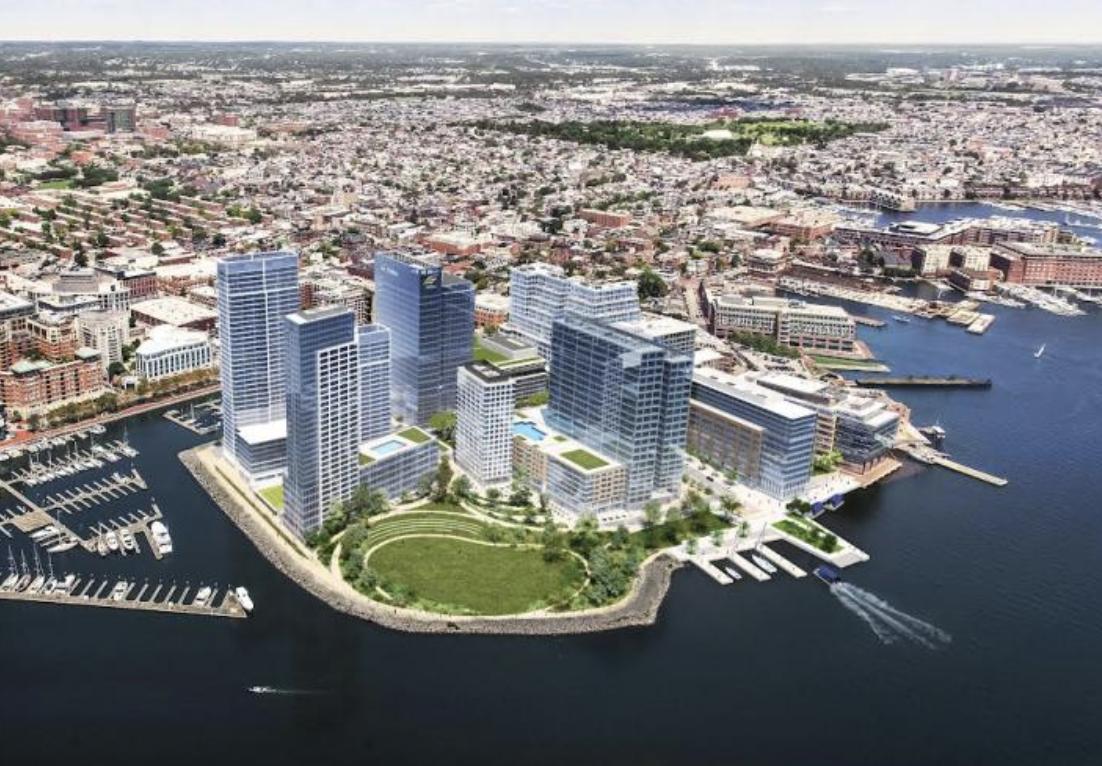
Construction by Armada Hoffler is underway at three different sites, simultaneously, on the 27-acre Harbor Point complex overlooking Baltimore’s Inner Harbor. Photo by Dennis Forney
Watching the development and revitalization of Baltimore’s inner harbor over the past 50 years has been something to behold.
Talbot County native and visionary James Rouse sparked much of the transformation with his Harborplace complex in the heart of the city many decades ago. He understood the allure of public waterfront spaces where people could gather, enjoy being outside, take long walks, and watch the dynamic interaction between the humming maritime activity of the harbor and the culture of the multi-faceted city surrounding it.
Pursued with the assistance of many of Baltimore’s leaders, Rouse’s vision continues to unfold today with the promise of creating an even more powerful nucleus around which the city can rebuild and thrive. The mixed-use high-rises of the Inner Harbor East area just a few blocks from the original Harborplace buildings have brought a new vibrancy and round-the-clock economy to what was once a monolithic industrial complex. Tens of thousands of residents in the apartments and condominiums overlooking the streets and harbor mean more and more business for restaurants, grocery stores and other retail establishments at sidewalk level. The miles-long public promenade linking so much of the waterfront’s businesses, residences, offices and parks add to the attractiveness.
The magic and positive contagion of Rouse’s big, waterfront thinking continues to spread, although the future of the city’s nearby central business district remains another question mark for the city.
The latest cranes accenting the inner harbor skyline belong to the massive Harbor Point project on one of the city’s most prominent pieces of waterfront property.
Baltimore Chrome Works, a previous occupant, was once reputed to be the world’s largest industrial processor of chromium ore, mined in Maryland. Situated on 27 acres and surrounded on three sides by water, the noisy and smokey facility and its associated wharves employed thousands, produced chromium chemicals for a wide variety of industrial and military uses, and, unfortunately, polluted the waters of the city’s harbor.
Following hundreds of millions spent to clear, clean, and cap the site to prevent further pollution of the harbor’s Patapsco River, the leveled property is well on its way to becoming what its developers call a sustainable urban hub.
Across from the Domino sugar facility, Harbor Point is well on its way to becoming a mixed-use home to three-million square feet of offices, retail space, residences and hotel rooms.
The 21-story Exelon building, completed in 2016 with LEED (Leadership in Energy Efficient Design) certification, towers over the site. It came on the heels of the eight-story Thames Street Wharf offices building, completed in 2010 as the first Harbor Point structure.
The partnership of Armada Hoffler, construction contractors, and Beatty Development, assisted by City of Baltimore economic development funding, are continuing at an aggressive pace. The 1405 Point building, with 289 residences and 18,000 square feet of retail space, opened in 2018 followed by the 12-story Wills Wharf complex of hotel and office space and its accompanying park.

This artist’s conception, provided by Armada Hoffler’s public relations firm, provides a sense of how the Harbor Point complex fronting on Baltimore’s Inner Harbor will appear when complete. The 27-acre site, tucked between Inner Harbor East Marina and Fells Point, includes nine acres of open space with a 4.5-acre lawn shown in the foreground.
The third, final and grandest phase of Harbor Point is now under construction. The global headquarters of financial firm T. Rowe Price will occupy two, seven-story buildings with 550,000 square feet of new office space. The final phase also includes more than 500 residential units and 60,000 square feet of new retail space. Completion is slated for 2024.
Louis Haddad, president and CEO of Virginia Beach-based Armada Hoffler, calls Harbor Point “a shining example of the kind of long-term, transformative neighborhood developments our company pursues. It is emerging as a safe, high-quality destination for Baltimore residents, professionals and visitors to spend time in. Harbor Point is helping the city retain quality businesses as a newer, vibrant alternative to the central business district. The vision of our partnership with Beatty Development Group is to create a cohesive, well-rounded neighborhood the city and its residents can be proud of.”
With hundreds of years of history, and counting, Baltimore is more proof that nothing is as constant as change.
Dennis Forney has been a publisher, journalist and columnist on the Delmarva Peninsula since 1972. He writes from his home on Grace Creek in Bozman.



Write a Letter to the Editor on this Article
We encourage readers to offer their point of view on this article by submitting the following form. Editing is sometimes necessary and is done at the discretion of the editorial staff.